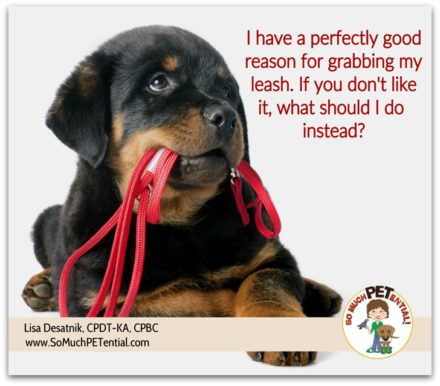I have seen and heard about the problem with large and small dogs and puppies. Instead of walking with all four paws on the ground on a loose leash as their head is facing forward or slightly to the side, they are grabbing at the leash to pull it, chew on it or play with it. (NOTE: I will refer to this as ‘bad leash behavior’ in this post.) Ugh, it is a frustrating problem!
 So, why does it happen and what can you do about it?
So, why does it happen and what can you do about it?
Why it happens
There are many reasons but what they all have in common is this. Behavior is simply a tool animals use to get consequences. If that behavior persists and even strengthens, then it is being reinforced by the environment.
That being said, it could be that a puppy has not had enough exercise prior to clipping that leash on which means your puppy has a greater need for mental and physical stimulation. Jumping at or tugging on a leash while the human on the other end is reacting in some way by either tugging back or pushing the puppy down or another reaction, may be even heightening the value then of your puppy’s bad leash behaviors since, from the puppy’s perspective, ‘bad leash behaviors’ cause games with humans to begin.
Another possible cause could be that your puppy has a real need for chewing or having something in his mouth, and the leash being in close proximity to your puppy’s mouth is an easy solution. The sensory stimulation from having something in his mouth could be a reinforcer for maintaining or strengthening those ‘bad leash behaviors’.
It could also be that your puppy is over stimulated by his environment or even stressed by his environment and those ‘bad leash behaviors’ are being reinforced by the release of tension.
Your sudden attention to your puppy could also be a source of reinforcement.
What can you do about it?
Well, one thing I do not recommend is the use of reprimands. Not only are there so many potential serious side effects from punishment (please see this post) including that punishment does not serve to teach your puppy what you want him to do instead and that your puppy will come to associate you with that negative, in order for punishment to be effective, it needs to be strong enough to stop the behavior.
Instead, think about the function that the ‘bad leash behaviors’ serve for your puppy – in other words, what is of value to your puppy that he gets by doing those behaviors? What can you do to prevent those unwanted behaviors from occurring in the first place (and getting reinforced)? And, what can you do to lower the value of that consequence and also teach your puppy a different behavior that can get him the same or greater value.
It may seem like a lot to think about but it really just takes some consideration, and practice.
These are just a few ideas:
Teach your puppy to sit with relaxed body muscles while you clip on the leash to begin reinforcing that response from the beginning.
Teach your puppy that walking beside you with a loose leash is what gets great things to happen. I may use a combination of tug toys, food, or the opportunity to sniff a mail post as a reinforcer for walking at my side.
Teach your puppy to hold a ball or other toy in his mouth on walks if your puppy is one that likes the sensory stimulation of having something in his mouth.
If you need to walk your dog at a time when you can not be in training mode (like when you are rushing him outside to go potty), you may want to use some management to help you both succeed. Using a double-ended clip, you can attach a metal choke chain (the only time I will use a choke chain) to the color and clip the leash onto the other end of the choke chain. Puppies are much less likely to get reinforcement from chewing on metal.
Additionally, if your puppy does get a hold of that leash, it is important that you be very careful so as to NOT reinforce it. Many times I have found that if I drop the leash immediately when a puppy mouth touches it (although still holding the end, just dropping the length to the ground) that it becomes boring.
Also, by knowing under what conditions your puppy is most likely to begin those ‘bad leash behaviors’ – like when he is stressed, over stimulated or lacking exercise, then take care to not walk him in those conditions until you have sufficiently taught him wanted behaviors, taken care to give him an acceptable outlet for getting his needs met (like giving him something to hold in his mouth), and/or are managing the situation which could include taking him to an environment where he will not be stressed so practice is less likely to occur.
Can I be of further help to you and your pet? Please contact me!






